Report: Environmental Management Practices at MAS Thurulie, Sri Lanka
VerifiedAdded on 2022/01/18
|21
|4889
|42
Report
AI Summary
This report provides an in-depth analysis of the environmental management practices implemented at MAS Thurulie, a leading sustainable clothing factory. The report begins with an acknowledgment and introduction to MAS Holdings, highlighting their commitment to environmental sustainability and their various certifications, including LEED Platinum and ISO 14001. It then delves into the specific environmental practices employed at the Thurulie factory, such as the use of natural lighting, solar power, cool roofs, and green roofs to reduce energy consumption. The report details the waste management system, including recycling and water treatment, and emphasizes the importance of native fauna and flora. Furthermore, it discusses the integration of lean systems and the use of renewable energy sources. The conclusion emphasizes the factory's carbon-neutral status and commitment to environmental responsibility. The report also includes recommendations for future improvements and references.
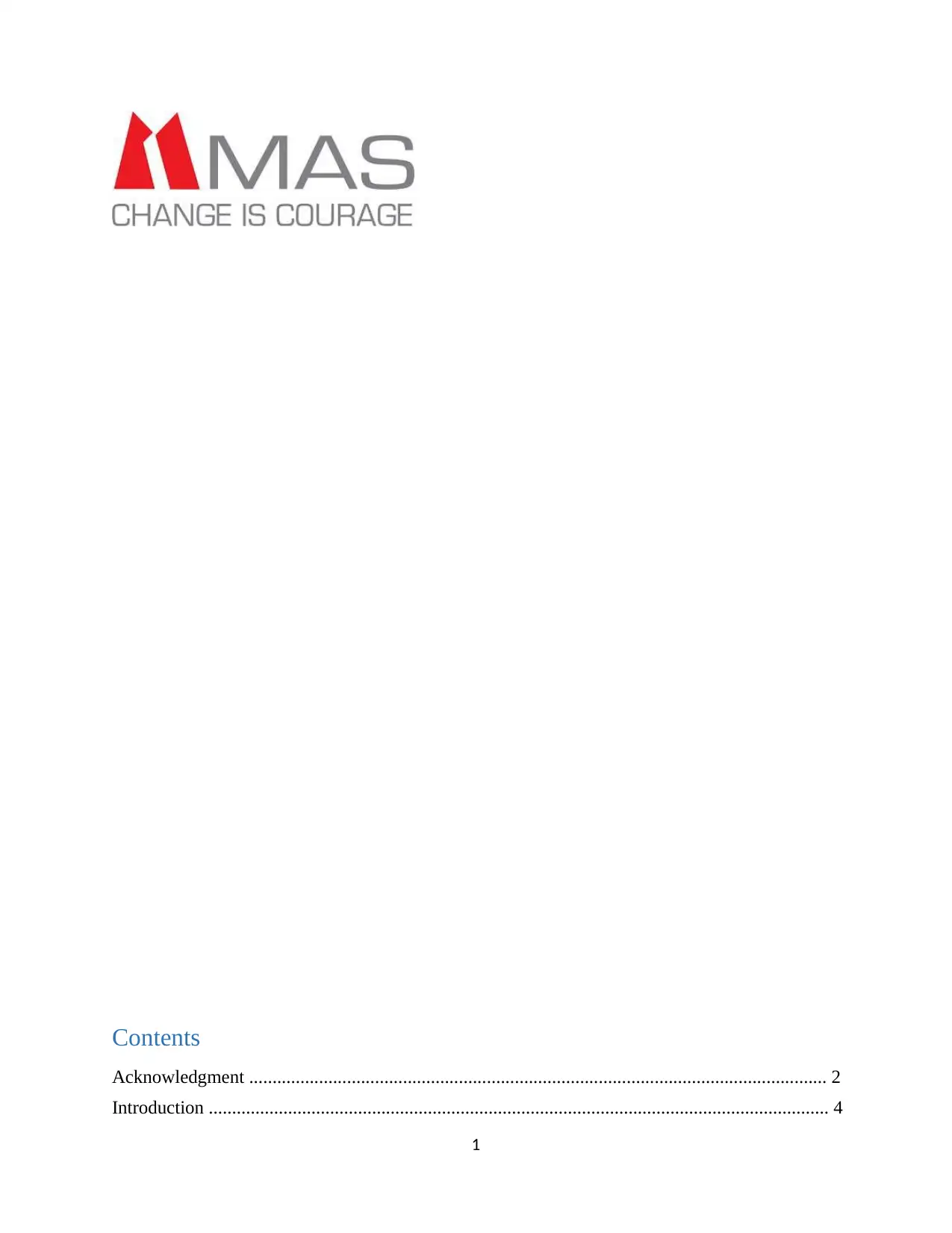
1
Contents
Acknowledgment ............................................................................................................................ 2
Introduction ..................................................................................................................................... 4
Contents
Acknowledgment ............................................................................................................................ 2
Introduction ..................................................................................................................................... 4
Paraphrase This Document
Need a fresh take? Get an instant paraphrase of this document with our AI Paraphraser

2
MAS Thurulie Environmental Management Practices ................................................................... 7
Environmental management system ......................................................................................................... 7
Waste management system ........................................................................................................... 11
Food waste .............................................................................................................................................. 11
Water waste ............................................................................................................................................ 11
Material waste ........................................................................................................................................ 12
Sustainable practices in MAS ....................................................................................................... 12
Sustainability in MAS Thurulie .................................................................................................... 15
Glaciers ......................................................................................................................................... 18
Conclusion .................................................................................................................................... 19
Recommendations ......................................................................................................................... 20
Attachments ................................................................................... Error! Bookmark not defined.
References ..................................................................................................................................... 21
Acknowledgment
First we would like convey our gratitude to NIBM for giving us this opportunity to pay a filed visit to
MAS Thurulie and get a practical knowledge about the environmental practices and sustainable practices
carried out within the premises.
MAS Thurulie Environmental Management Practices ................................................................... 7
Environmental management system ......................................................................................................... 7
Waste management system ........................................................................................................... 11
Food waste .............................................................................................................................................. 11
Water waste ............................................................................................................................................ 11
Material waste ........................................................................................................................................ 12
Sustainable practices in MAS ....................................................................................................... 12
Sustainability in MAS Thurulie .................................................................................................... 15
Glaciers ......................................................................................................................................... 18
Conclusion .................................................................................................................................... 19
Recommendations ......................................................................................................................... 20
Attachments ................................................................................... Error! Bookmark not defined.
References ..................................................................................................................................... 21
Acknowledgment
First we would like convey our gratitude to NIBM for giving us this opportunity to pay a filed visit to
MAS Thurulie and get a practical knowledge about the environmental practices and sustainable practices
carried out within the premises.
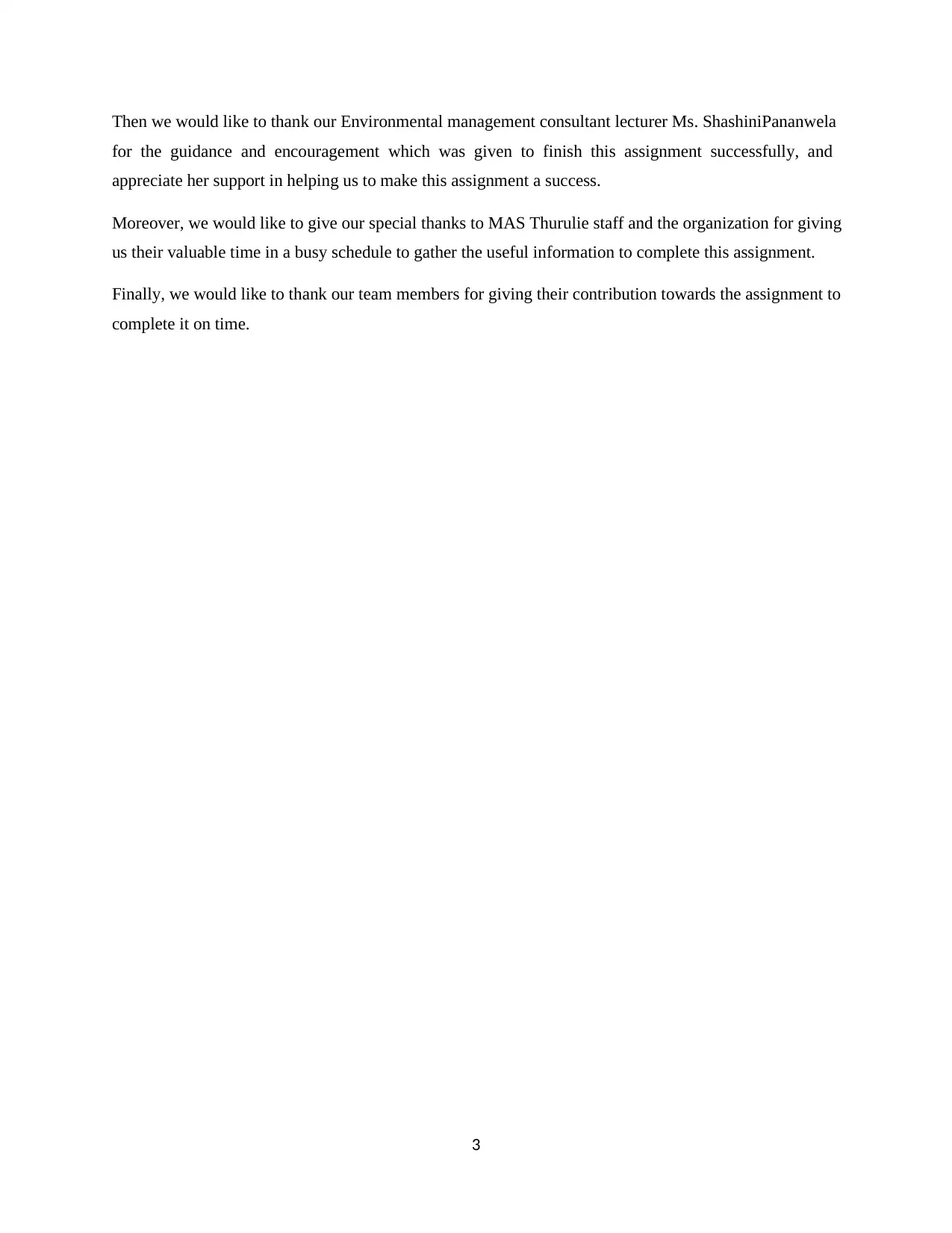
3
Then we would like to thank our Environmental management consultant lecturer Ms. ShashiniPananwela
for the guidance and encouragement which was given to finish this assignment successfully, and
appreciate her support in helping us to make this assignment a success.
Moreover, we would like to give our special thanks to MAS Thurulie staff and the organization for giving
us their valuable time in a busy schedule to gather the useful information to complete this assignment.
Finally, we would like to thank our team members for giving their contribution towards the assignment to
complete it on time.
Then we would like to thank our Environmental management consultant lecturer Ms. ShashiniPananwela
for the guidance and encouragement which was given to finish this assignment successfully, and
appreciate her support in helping us to make this assignment a success.
Moreover, we would like to give our special thanks to MAS Thurulie staff and the organization for giving
us their valuable time in a busy schedule to gather the useful information to complete this assignment.
Finally, we would like to thank our team members for giving their contribution towards the assignment to
complete it on time.
⊘ This is a preview!⊘
Do you want full access?
Subscribe today to unlock all pages.

Trusted by 1+ million students worldwide
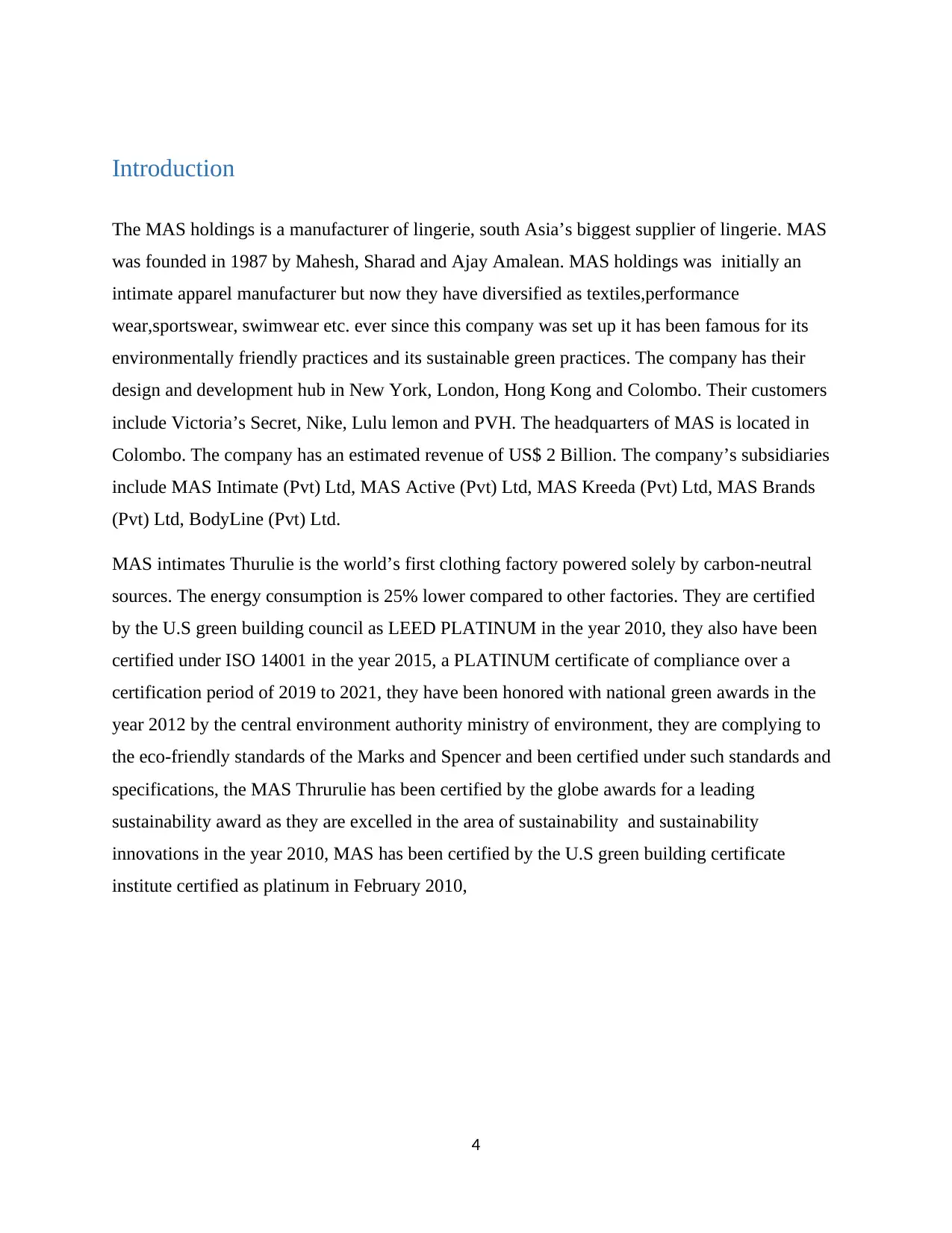
4
Introduction
The MAS holdings is a manufacturer of lingerie, south Asia’s biggest supplier of lingerie. MAS
was founded in 1987 by Mahesh, Sharad and Ajay Amalean. MAS holdings was initially an
intimate apparel manufacturer but now they have diversified as textiles,performance
wear,sportswear, swimwear etc. ever since this company was set up it has been famous for its
environmentally friendly practices and its sustainable green practices. The company has their
design and development hub in New York, London, Hong Kong and Colombo. Their customers
include Victoria’s Secret, Nike, Lulu lemon and PVH. The headquarters of MAS is located in
Colombo. The company has an estimated revenue of US$ 2 Billion. The company’s subsidiaries
include MAS Intimate (Pvt) Ltd, MAS Active (Pvt) Ltd, MAS Kreeda (Pvt) Ltd, MAS Brands
(Pvt) Ltd, BodyLine (Pvt) Ltd.
MAS intimates Thurulie is the world’s first clothing factory powered solely by carbon-neutral
sources. The energy consumption is 25% lower compared to other factories. They are certified
by the U.S green building council as LEED PLATINUM in the year 2010, they also have been
certified under ISO 14001 in the year 2015, a PLATINUM certificate of compliance over a
certification period of 2019 to 2021, they have been honored with national green awards in the
year 2012 by the central environment authority ministry of environment, they are complying to
the eco-friendly standards of the Marks and Spencer and been certified under such standards and
specifications, the MAS Thrurulie has been certified by the globe awards for a leading
sustainability award as they are excelled in the area of sustainability and sustainability
innovations in the year 2010, MAS has been certified by the U.S green building certificate
institute certified as platinum in February 2010,
Introduction
The MAS holdings is a manufacturer of lingerie, south Asia’s biggest supplier of lingerie. MAS
was founded in 1987 by Mahesh, Sharad and Ajay Amalean. MAS holdings was initially an
intimate apparel manufacturer but now they have diversified as textiles,performance
wear,sportswear, swimwear etc. ever since this company was set up it has been famous for its
environmentally friendly practices and its sustainable green practices. The company has their
design and development hub in New York, London, Hong Kong and Colombo. Their customers
include Victoria’s Secret, Nike, Lulu lemon and PVH. The headquarters of MAS is located in
Colombo. The company has an estimated revenue of US$ 2 Billion. The company’s subsidiaries
include MAS Intimate (Pvt) Ltd, MAS Active (Pvt) Ltd, MAS Kreeda (Pvt) Ltd, MAS Brands
(Pvt) Ltd, BodyLine (Pvt) Ltd.
MAS intimates Thurulie is the world’s first clothing factory powered solely by carbon-neutral
sources. The energy consumption is 25% lower compared to other factories. They are certified
by the U.S green building council as LEED PLATINUM in the year 2010, they also have been
certified under ISO 14001 in the year 2015, a PLATINUM certificate of compliance over a
certification period of 2019 to 2021, they have been honored with national green awards in the
year 2012 by the central environment authority ministry of environment, they are complying to
the eco-friendly standards of the Marks and Spencer and been certified under such standards and
specifications, the MAS Thrurulie has been certified by the globe awards for a leading
sustainability award as they are excelled in the area of sustainability and sustainability
innovations in the year 2010, MAS has been certified by the U.S green building certificate
institute certified as platinum in February 2010,
Paraphrase This Document
Need a fresh take? Get an instant paraphrase of this document with our AI Paraphraser
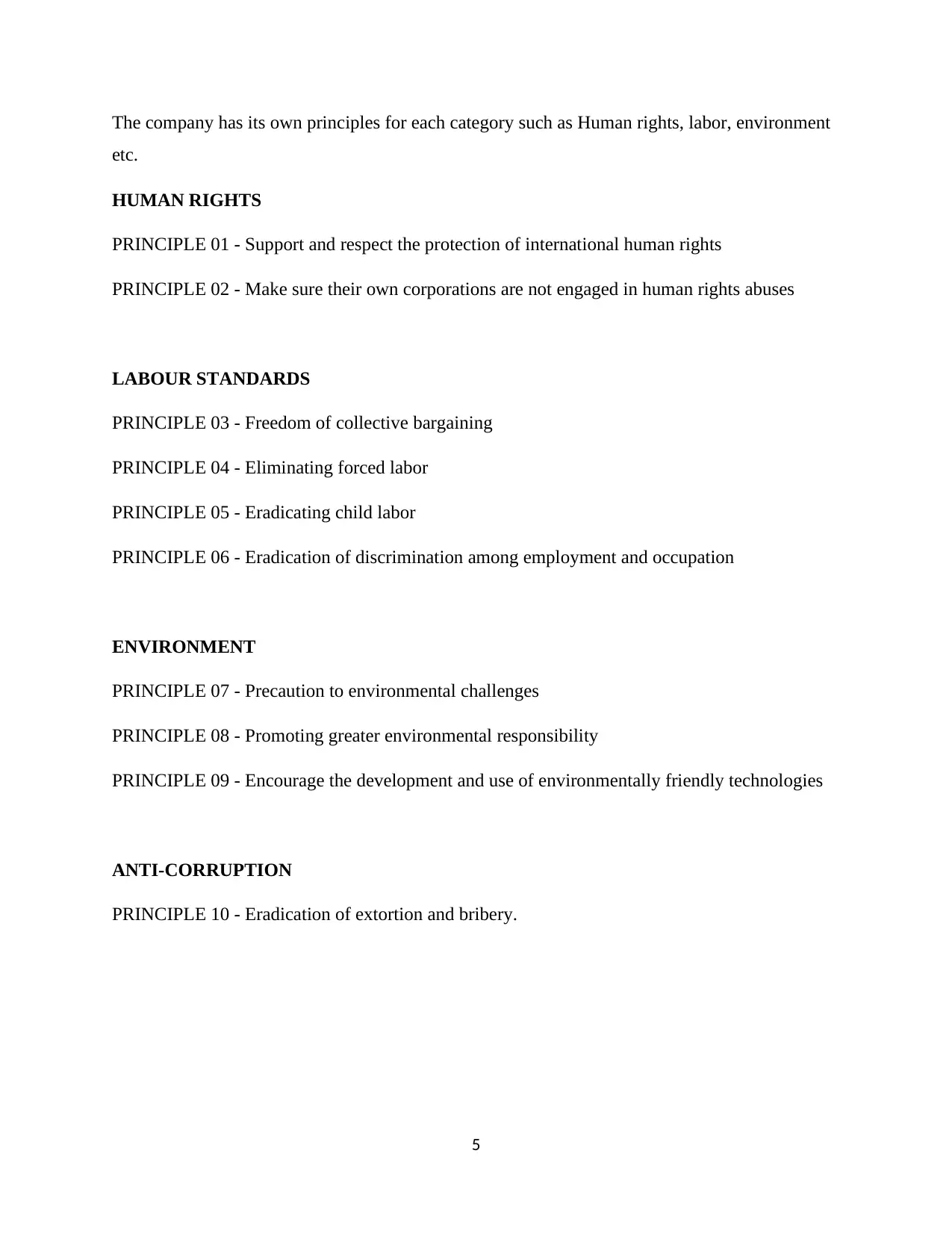
5
The company has its own principles for each category such as Human rights, labor, environment
etc.
HUMAN RIGHTS
PRINCIPLE 01 - Support and respect the protection of international human rights
PRINCIPLE 02 - Make sure their own corporations are not engaged in human rights abuses
LABOUR STANDARDS
PRINCIPLE 03 - Freedom of collective bargaining
PRINCIPLE 04 - Eliminating forced labor
PRINCIPLE 05 - Eradicating child labor
PRINCIPLE 06 - Eradication of discrimination among employment and occupation
ENVIRONMENT
PRINCIPLE 07 - Precaution to environmental challenges
PRINCIPLE 08 - Promoting greater environmental responsibility
PRINCIPLE 09 - Encourage the development and use of environmentally friendly technologies
ANTI-CORRUPTION
PRINCIPLE 10 - Eradication of extortion and bribery.
The company has its own principles for each category such as Human rights, labor, environment
etc.
HUMAN RIGHTS
PRINCIPLE 01 - Support and respect the protection of international human rights
PRINCIPLE 02 - Make sure their own corporations are not engaged in human rights abuses
LABOUR STANDARDS
PRINCIPLE 03 - Freedom of collective bargaining
PRINCIPLE 04 - Eliminating forced labor
PRINCIPLE 05 - Eradicating child labor
PRINCIPLE 06 - Eradication of discrimination among employment and occupation
ENVIRONMENT
PRINCIPLE 07 - Precaution to environmental challenges
PRINCIPLE 08 - Promoting greater environmental responsibility
PRINCIPLE 09 - Encourage the development and use of environmentally friendly technologies
ANTI-CORRUPTION
PRINCIPLE 10 - Eradication of extortion and bribery.
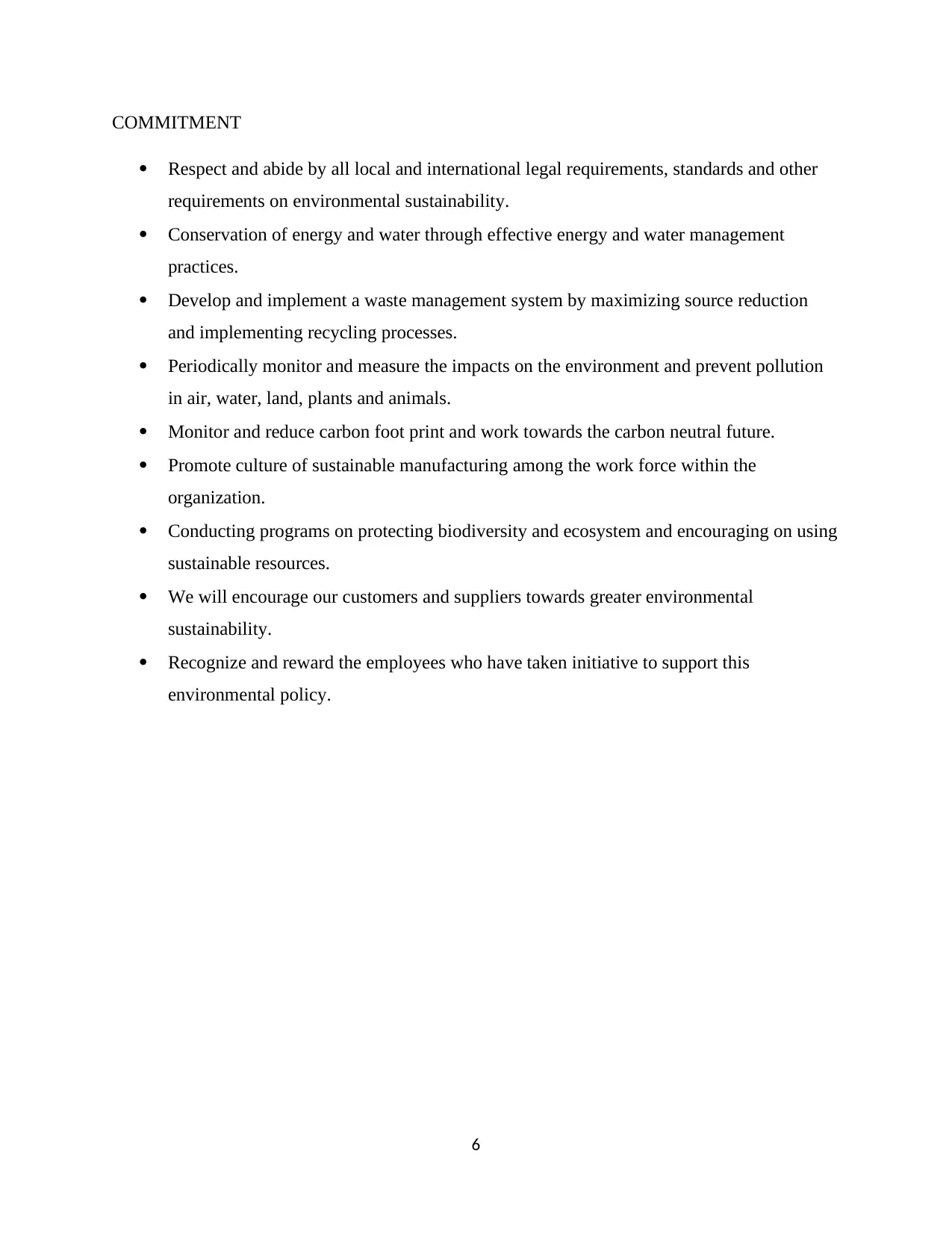
6
COMMITMENT
Respect and abide by all local and international legal requirements, standards and other
requirements on environmental sustainability.
Conservation of energy and water through effective energy and water management
practices.
Develop and implement a waste management system by maximizing source reduction
and implementing recycling processes.
Periodically monitor and measure the impacts on the environment and prevent pollution
in air, water, land, plants and animals.
Monitor and reduce carbon foot print and work towards the carbon neutral future.
Promote culture of sustainable manufacturing among the work force within the
organization.
Conducting programs on protecting biodiversity and ecosystem and encouraging on using
sustainable resources.
We will encourage our customers and suppliers towards greater environmental
sustainability.
Recognize and reward the employees who have taken initiative to support this
environmental policy.
COMMITMENT
Respect and abide by all local and international legal requirements, standards and other
requirements on environmental sustainability.
Conservation of energy and water through effective energy and water management
practices.
Develop and implement a waste management system by maximizing source reduction
and implementing recycling processes.
Periodically monitor and measure the impacts on the environment and prevent pollution
in air, water, land, plants and animals.
Monitor and reduce carbon foot print and work towards the carbon neutral future.
Promote culture of sustainable manufacturing among the work force within the
organization.
Conducting programs on protecting biodiversity and ecosystem and encouraging on using
sustainable resources.
We will encourage our customers and suppliers towards greater environmental
sustainability.
Recognize and reward the employees who have taken initiative to support this
environmental policy.
⊘ This is a preview!⊘
Do you want full access?
Subscribe today to unlock all pages.

Trusted by 1+ million students worldwide
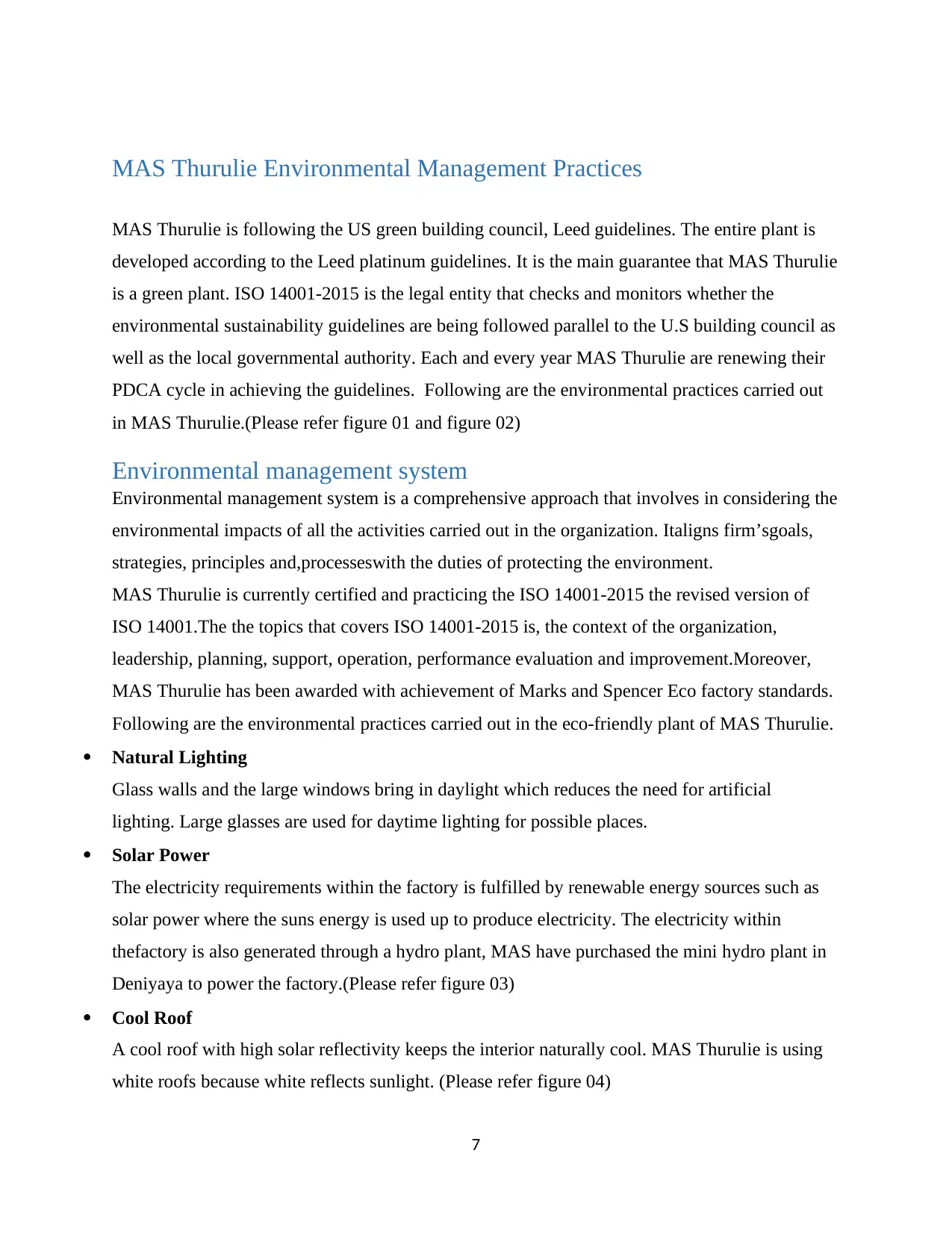
7
MAS Thurulie Environmental Management Practices
MAS Thurulie is following the US green building council, Leed guidelines. The entire plant is
developed according to the Leed platinum guidelines. It is the main guarantee that MAS Thurulie
is a green plant. ISO 14001-2015 is the legal entity that checks and monitors whether the
environmental sustainability guidelines are being followed parallel to the U.S building council as
well as the local governmental authority. Each and every year MAS Thurulie are renewing their
PDCA cycle in achieving the guidelines. Following are the environmental practices carried out
in MAS Thurulie.(Please refer figure 01 and figure 02)
Environmental management system
Environmental management system is a comprehensive approach that involves in considering the
environmental impacts of all the activities carried out in the organization. Italigns firm’sgoals,
strategies, principles and,processeswith the duties of protecting the environment.
MAS Thurulie is currently certified and practicing the ISO 14001-2015 the revised version of
ISO 14001.The the topics that covers ISO 14001-2015 is, the context of the organization,
leadership, planning, support, operation, performance evaluation and improvement.Moreover,
MAS Thurulie has been awarded with achievement of Marks and Spencer Eco factory standards.
Following are the environmental practices carried out in the eco-friendly plant of MAS Thurulie.
Natural Lighting
Glass walls and the large windows bring in daylight which reduces the need for artificial
lighting. Large glasses are used for daytime lighting for possible places.
Solar Power
The electricity requirements within the factory is fulfilled by renewable energy sources such as
solar power where the suns energy is used up to produce electricity. The electricity within
thefactory is also generated through a hydro plant, MAS have purchased the mini hydro plant in
Deniyaya to power the factory.(Please refer figure 03)
Cool Roof
A cool roof with high solar reflectivity keeps the interior naturally cool. MAS Thurulie is using
white roofs because white reflects sunlight. (Please refer figure 04)
MAS Thurulie Environmental Management Practices
MAS Thurulie is following the US green building council, Leed guidelines. The entire plant is
developed according to the Leed platinum guidelines. It is the main guarantee that MAS Thurulie
is a green plant. ISO 14001-2015 is the legal entity that checks and monitors whether the
environmental sustainability guidelines are being followed parallel to the U.S building council as
well as the local governmental authority. Each and every year MAS Thurulie are renewing their
PDCA cycle in achieving the guidelines. Following are the environmental practices carried out
in MAS Thurulie.(Please refer figure 01 and figure 02)
Environmental management system
Environmental management system is a comprehensive approach that involves in considering the
environmental impacts of all the activities carried out in the organization. Italigns firm’sgoals,
strategies, principles and,processeswith the duties of protecting the environment.
MAS Thurulie is currently certified and practicing the ISO 14001-2015 the revised version of
ISO 14001.The the topics that covers ISO 14001-2015 is, the context of the organization,
leadership, planning, support, operation, performance evaluation and improvement.Moreover,
MAS Thurulie has been awarded with achievement of Marks and Spencer Eco factory standards.
Following are the environmental practices carried out in the eco-friendly plant of MAS Thurulie.
Natural Lighting
Glass walls and the large windows bring in daylight which reduces the need for artificial
lighting. Large glasses are used for daytime lighting for possible places.
Solar Power
The electricity requirements within the factory is fulfilled by renewable energy sources such as
solar power where the suns energy is used up to produce electricity. The electricity within
thefactory is also generated through a hydro plant, MAS have purchased the mini hydro plant in
Deniyaya to power the factory.(Please refer figure 03)
Cool Roof
A cool roof with high solar reflectivity keeps the interior naturally cool. MAS Thurulie is using
white roofs because white reflects sunlight. (Please refer figure 04)
Paraphrase This Document
Need a fresh take? Get an instant paraphrase of this document with our AI Paraphraser

8
Green Roof
The green roof cuts off the solar radiation from above and eliminates heat-island.Above the slab
roofs MASThurulie have used soil because soil is the most efficient heat absorbent media.
Therefore the inside building will be cooler and there will be less heat entering the building.
(Please refer figure 05)
Brick Wall
The walls of the factory are made up of brick which is unburnt and compressed. Therefore the
CO2 emission will be 0%.This brick is composed of soil, small amount of cement and sand
which has much more cooling effect in comparison to the traditional cement building materials.
This cools the entire premises reducing the need for air conditioner within the building. This is
also less costly and eco-friendly. Mud is the significant building material used by our ancestors
and it has so many benefits than using the man-made cement mixtures and building materials.
(The green roof, cool roof and the brick wall is contributing towards less energy consumption
and the cooling of the building.Moreover, MAS Thurulie has a lower maintenance cost through
these features in comparing with the other plants.(Please refer figure 06)
Energy efficient lighting
The lights inside the premises are LED lights which helps in lower consumption of electricity
thereby conserving the energy resources.
Renewable Electricity
The two main renewable resources used are hydro and solar for generating electricity
Carbon Neutral
Using renewable sources that do not emit carbon into the air. Instead of using fossil fuels which
releases an enormous amount of carbon particles into the air, they use renewable resources such
as sunlight to generate electricity that has zero carbon emissions and also use hydroelectricity
that has zero carbon emissions. Apart from this they also pant thousands of trees that take up all
the carbon in the air and purify and clean the air which ultimately makes them carbon neutral.
Green Roof
The green roof cuts off the solar radiation from above and eliminates heat-island.Above the slab
roofs MASThurulie have used soil because soil is the most efficient heat absorbent media.
Therefore the inside building will be cooler and there will be less heat entering the building.
(Please refer figure 05)
Brick Wall
The walls of the factory are made up of brick which is unburnt and compressed. Therefore the
CO2 emission will be 0%.This brick is composed of soil, small amount of cement and sand
which has much more cooling effect in comparison to the traditional cement building materials.
This cools the entire premises reducing the need for air conditioner within the building. This is
also less costly and eco-friendly. Mud is the significant building material used by our ancestors
and it has so many benefits than using the man-made cement mixtures and building materials.
(The green roof, cool roof and the brick wall is contributing towards less energy consumption
and the cooling of the building.Moreover, MAS Thurulie has a lower maintenance cost through
these features in comparing with the other plants.(Please refer figure 06)
Energy efficient lighting
The lights inside the premises are LED lights which helps in lower consumption of electricity
thereby conserving the energy resources.
Renewable Electricity
The two main renewable resources used are hydro and solar for generating electricity
Carbon Neutral
Using renewable sources that do not emit carbon into the air. Instead of using fossil fuels which
releases an enormous amount of carbon particles into the air, they use renewable resources such
as sunlight to generate electricity that has zero carbon emissions and also use hydroelectricity
that has zero carbon emissions. Apart from this they also pant thousands of trees that take up all
the carbon in the air and purify and clean the air which ultimately makes them carbon neutral.
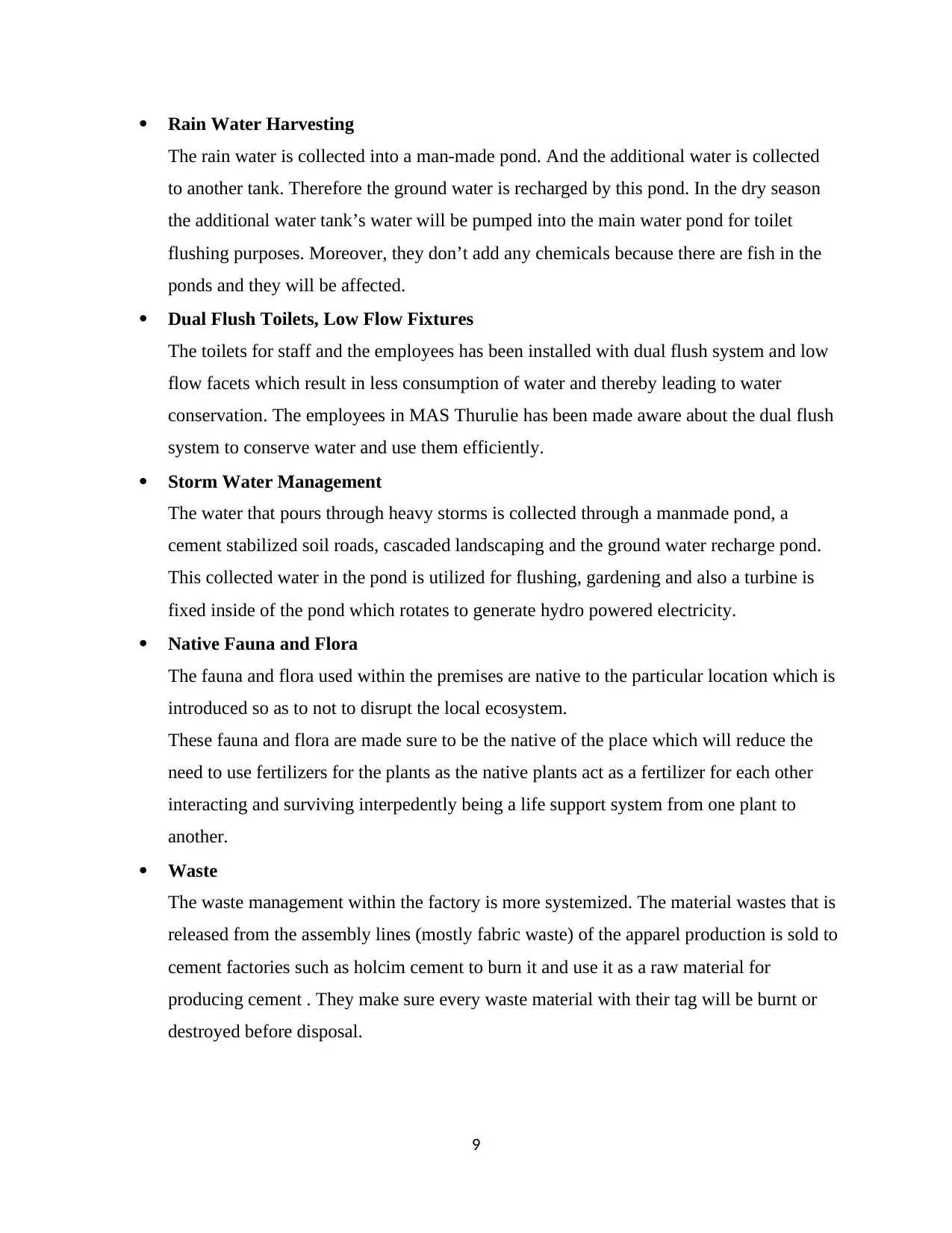
9
Rain Water Harvesting
The rain water is collected into a man-made pond. And the additional water is collected
to another tank. Therefore the ground water is recharged by this pond. In the dry season
the additional water tank’s water will be pumped into the main water pond for toilet
flushing purposes. Moreover, they don’t add any chemicals because there are fish in the
ponds and they will be affected.
Dual Flush Toilets, Low Flow Fixtures
The toilets for staff and the employees has been installed with dual flush system and low
flow facets which result in less consumption of water and thereby leading to water
conservation. The employees in MAS Thurulie has been made aware about the dual flush
system to conserve water and use them efficiently.
Storm Water Management
The water that pours through heavy storms is collected through a manmade pond, a
cement stabilized soil roads, cascaded landscaping and the ground water recharge pond.
This collected water in the pond is utilized for flushing, gardening and also a turbine is
fixed inside of the pond which rotates to generate hydro powered electricity.
Native Fauna and Flora
The fauna and flora used within the premises are native to the particular location which is
introduced so as to not to disrupt the local ecosystem.
These fauna and flora are made sure to be the native of the place which will reduce the
need to use fertilizers for the plants as the native plants act as a fertilizer for each other
interacting and surviving interpedently being a life support system from one plant to
another.
Waste
The waste management within the factory is more systemized. The material wastes that is
released from the assembly lines (mostly fabric waste) of the apparel production is sold to
cement factories such as holcim cement to burn it and use it as a raw material for
producing cement . They make sure every waste material with their tag will be burnt or
destroyed before disposal.
Rain Water Harvesting
The rain water is collected into a man-made pond. And the additional water is collected
to another tank. Therefore the ground water is recharged by this pond. In the dry season
the additional water tank’s water will be pumped into the main water pond for toilet
flushing purposes. Moreover, they don’t add any chemicals because there are fish in the
ponds and they will be affected.
Dual Flush Toilets, Low Flow Fixtures
The toilets for staff and the employees has been installed with dual flush system and low
flow facets which result in less consumption of water and thereby leading to water
conservation. The employees in MAS Thurulie has been made aware about the dual flush
system to conserve water and use them efficiently.
Storm Water Management
The water that pours through heavy storms is collected through a manmade pond, a
cement stabilized soil roads, cascaded landscaping and the ground water recharge pond.
This collected water in the pond is utilized for flushing, gardening and also a turbine is
fixed inside of the pond which rotates to generate hydro powered electricity.
Native Fauna and Flora
The fauna and flora used within the premises are native to the particular location which is
introduced so as to not to disrupt the local ecosystem.
These fauna and flora are made sure to be the native of the place which will reduce the
need to use fertilizers for the plants as the native plants act as a fertilizer for each other
interacting and surviving interpedently being a life support system from one plant to
another.
Waste
The waste management within the factory is more systemized. The material wastes that is
released from the assembly lines (mostly fabric waste) of the apparel production is sold to
cement factories such as holcim cement to burn it and use it as a raw material for
producing cement . They make sure every waste material with their tag will be burnt or
destroyed before disposal.
⊘ This is a preview!⊘
Do you want full access?
Subscribe today to unlock all pages.

Trusted by 1+ million students worldwide
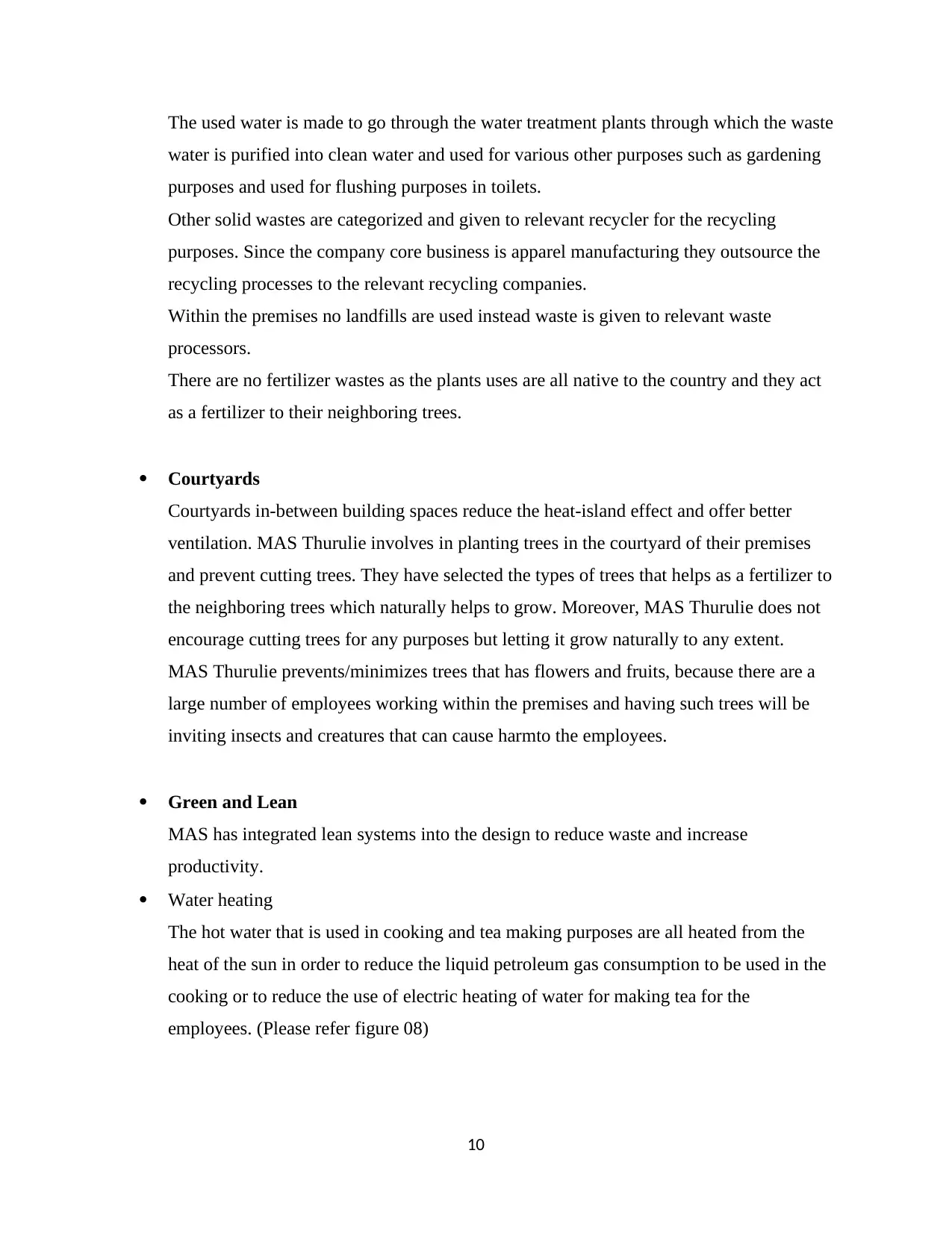
10
The used water is made to go through the water treatment plants through which the waste
water is purified into clean water and used for various other purposes such as gardening
purposes and used for flushing purposes in toilets.
Other solid wastes are categorized and given to relevant recycler for the recycling
purposes. Since the company core business is apparel manufacturing they outsource the
recycling processes to the relevant recycling companies.
Within the premises no landfills are used instead waste is given to relevant waste
processors.
There are no fertilizer wastes as the plants uses are all native to the country and they act
as a fertilizer to their neighboring trees.
Courtyards
Courtyards in-between building spaces reduce the heat-island effect and offer better
ventilation. MAS Thurulie involves in planting trees in the courtyard of their premises
and prevent cutting trees. They have selected the types of trees that helps as a fertilizer to
the neighboring trees which naturally helps to grow. Moreover, MAS Thurulie does not
encourage cutting trees for any purposes but letting it grow naturally to any extent.
MAS Thurulie prevents/minimizes trees that has flowers and fruits, because there are a
large number of employees working within the premises and having such trees will be
inviting insects and creatures that can cause harmto the employees.
Green and Lean
MAS has integrated lean systems into the design to reduce waste and increase
productivity.
Water heating
The hot water that is used in cooking and tea making purposes are all heated from the
heat of the sun in order to reduce the liquid petroleum gas consumption to be used in the
cooking or to reduce the use of electric heating of water for making tea for the
employees. (Please refer figure 08)
The used water is made to go through the water treatment plants through which the waste
water is purified into clean water and used for various other purposes such as gardening
purposes and used for flushing purposes in toilets.
Other solid wastes are categorized and given to relevant recycler for the recycling
purposes. Since the company core business is apparel manufacturing they outsource the
recycling processes to the relevant recycling companies.
Within the premises no landfills are used instead waste is given to relevant waste
processors.
There are no fertilizer wastes as the plants uses are all native to the country and they act
as a fertilizer to their neighboring trees.
Courtyards
Courtyards in-between building spaces reduce the heat-island effect and offer better
ventilation. MAS Thurulie involves in planting trees in the courtyard of their premises
and prevent cutting trees. They have selected the types of trees that helps as a fertilizer to
the neighboring trees which naturally helps to grow. Moreover, MAS Thurulie does not
encourage cutting trees for any purposes but letting it grow naturally to any extent.
MAS Thurulie prevents/minimizes trees that has flowers and fruits, because there are a
large number of employees working within the premises and having such trees will be
inviting insects and creatures that can cause harmto the employees.
Green and Lean
MAS has integrated lean systems into the design to reduce waste and increase
productivity.
Water heating
The hot water that is used in cooking and tea making purposes are all heated from the
heat of the sun in order to reduce the liquid petroleum gas consumption to be used in the
cooking or to reduce the use of electric heating of water for making tea for the
employees. (Please refer figure 08)
Paraphrase This Document
Need a fresh take? Get an instant paraphrase of this document with our AI Paraphraser
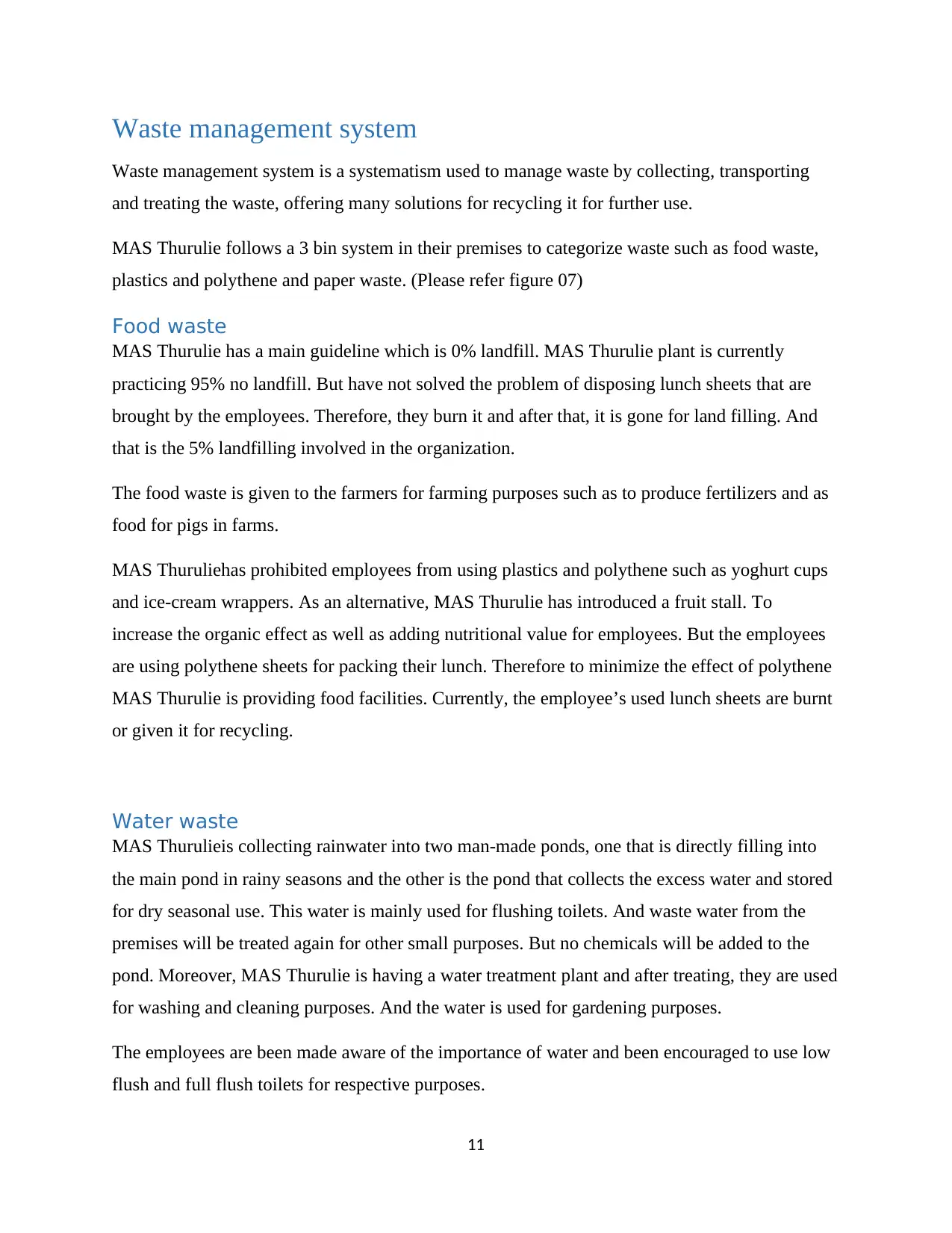
11
Waste management system
Waste management system is a systematism used to manage waste by collecting, transporting
and treating the waste, offering many solutions for recycling it for further use.
MAS Thurulie follows a 3 bin system in their premises to categorize waste such as food waste,
plastics and polythene and paper waste. (Please refer figure 07)
Food waste
MAS Thurulie has a main guideline which is 0% landfill. MAS Thurulie plant is currently
practicing 95% no landfill. But have not solved the problem of disposing lunch sheets that are
brought by the employees. Therefore, they burn it and after that, it is gone for land filling. And
that is the 5% landfilling involved in the organization.
The food waste is given to the farmers for farming purposes such as to produce fertilizers and as
food for pigs in farms.
MAS Thuruliehas prohibited employees from using plastics and polythene such as yoghurt cups
and ice-cream wrappers. As an alternative, MAS Thurulie has introduced a fruit stall. To
increase the organic effect as well as adding nutritional value for employees. But the employees
are using polythene sheets for packing their lunch. Therefore to minimize the effect of polythene
MAS Thurulie is providing food facilities. Currently, the employee’s used lunch sheets are burnt
or given it for recycling.
Water waste
MAS Thurulieis collecting rainwater into two man-made ponds, one that is directly filling into
the main pond in rainy seasons and the other is the pond that collects the excess water and stored
for dry seasonal use. This water is mainly used for flushing toilets. And waste water from the
premises will be treated again for other small purposes. But no chemicals will be added to the
pond. Moreover, MAS Thurulie is having a water treatment plant and after treating, they are used
for washing and cleaning purposes. And the water is used for gardening purposes.
The employees are been made aware of the importance of water and been encouraged to use low
flush and full flush toilets for respective purposes.
Waste management system
Waste management system is a systematism used to manage waste by collecting, transporting
and treating the waste, offering many solutions for recycling it for further use.
MAS Thurulie follows a 3 bin system in their premises to categorize waste such as food waste,
plastics and polythene and paper waste. (Please refer figure 07)
Food waste
MAS Thurulie has a main guideline which is 0% landfill. MAS Thurulie plant is currently
practicing 95% no landfill. But have not solved the problem of disposing lunch sheets that are
brought by the employees. Therefore, they burn it and after that, it is gone for land filling. And
that is the 5% landfilling involved in the organization.
The food waste is given to the farmers for farming purposes such as to produce fertilizers and as
food for pigs in farms.
MAS Thuruliehas prohibited employees from using plastics and polythene such as yoghurt cups
and ice-cream wrappers. As an alternative, MAS Thurulie has introduced a fruit stall. To
increase the organic effect as well as adding nutritional value for employees. But the employees
are using polythene sheets for packing their lunch. Therefore to minimize the effect of polythene
MAS Thurulie is providing food facilities. Currently, the employee’s used lunch sheets are burnt
or given it for recycling.
Water waste
MAS Thurulieis collecting rainwater into two man-made ponds, one that is directly filling into
the main pond in rainy seasons and the other is the pond that collects the excess water and stored
for dry seasonal use. This water is mainly used for flushing toilets. And waste water from the
premises will be treated again for other small purposes. But no chemicals will be added to the
pond. Moreover, MAS Thurulie is having a water treatment plant and after treating, they are used
for washing and cleaning purposes. And the water is used for gardening purposes.
The employees are been made aware of the importance of water and been encouraged to use low
flush and full flush toilets for respective purposes.
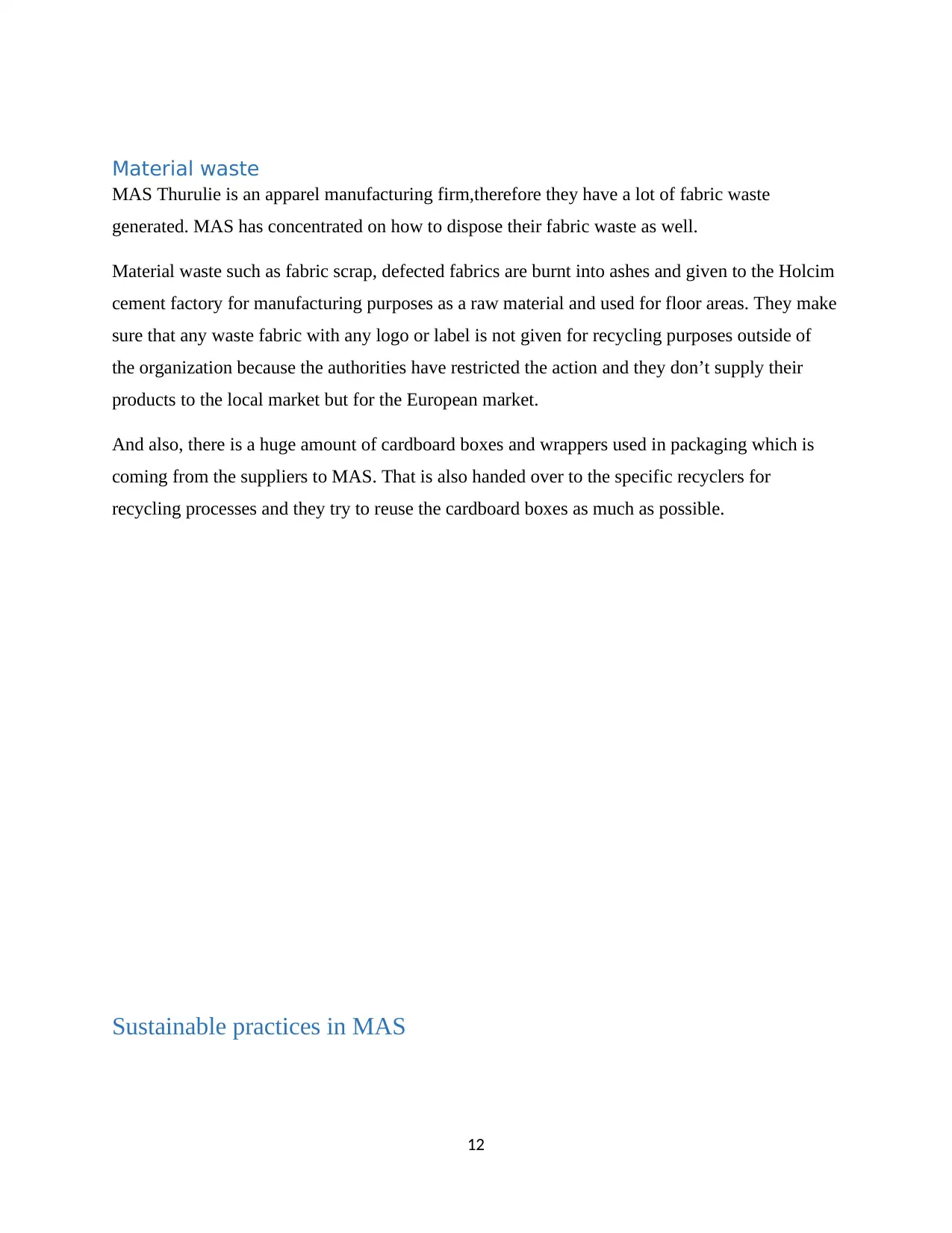
12
Material waste
MAS Thurulie is an apparel manufacturing firm,therefore they have a lot of fabric waste
generated. MAS has concentrated on how to dispose their fabric waste as well.
Material waste such as fabric scrap, defected fabrics are burnt into ashes and given to the Holcim
cement factory for manufacturing purposes as a raw material and used for floor areas. They make
sure that any waste fabric with any logo or label is not given for recycling purposes outside of
the organization because the authorities have restricted the action and they don’t supply their
products to the local market but for the European market.
And also, there is a huge amount of cardboard boxes and wrappers used in packaging which is
coming from the suppliers to MAS. That is also handed over to the specific recyclers for
recycling processes and they try to reuse the cardboard boxes as much as possible.
Sustainable practices in MAS
Material waste
MAS Thurulie is an apparel manufacturing firm,therefore they have a lot of fabric waste
generated. MAS has concentrated on how to dispose their fabric waste as well.
Material waste such as fabric scrap, defected fabrics are burnt into ashes and given to the Holcim
cement factory for manufacturing purposes as a raw material and used for floor areas. They make
sure that any waste fabric with any logo or label is not given for recycling purposes outside of
the organization because the authorities have restricted the action and they don’t supply their
products to the local market but for the European market.
And also, there is a huge amount of cardboard boxes and wrappers used in packaging which is
coming from the suppliers to MAS. That is also handed over to the specific recyclers for
recycling processes and they try to reuse the cardboard boxes as much as possible.
Sustainable practices in MAS
⊘ This is a preview!⊘
Do you want full access?
Subscribe today to unlock all pages.

Trusted by 1+ million students worldwide
1 out of 21
Your All-in-One AI-Powered Toolkit for Academic Success.
+13062052269
info@desklib.com
Available 24*7 on WhatsApp / Email
![[object Object]](/_next/static/media/star-bottom.7253800d.svg)
Unlock your academic potential
Copyright © 2020–2025 A2Z Services. All Rights Reserved. Developed and managed by ZUCOL.
